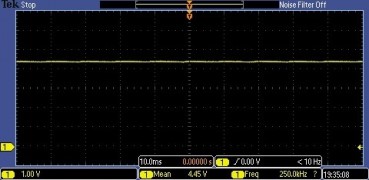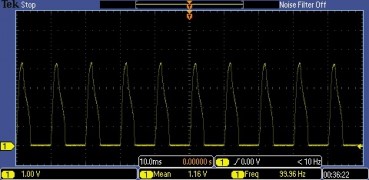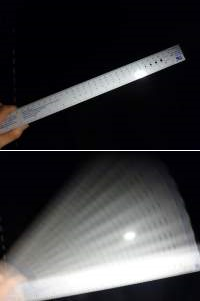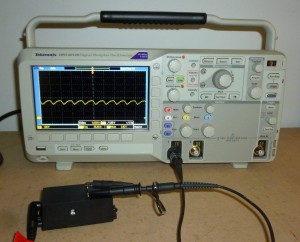FAQ - Flicker in LED Lighting
AC lighting including incandescent, CFL and LED types generally exhibit varying degrees of flicker; usually at double the line frequency (100Hz flicker for a 50Hz mains frequency or 120Hz for a 60Hz mains frequency). While flicker above 75 Hz is not noticeable to most individuals, the perceptibility of flicker is not just a function of frequency but also the relative intensity of the peaks and troughs of the light output waveform (modulation) and the shape of the waveform, which describes the duration of varying light levels over time within each cycle (duty cycle).
The degree of modulation, reflected in the percent flicker and flicker index metrics described below, has a substantial effect on the maximum frequency at which flicker is detectable, called the flicker fusion threshold. Deeper modulation and longer instances of low light intensity, corresponding to a higher percent flicker and flicker index respectively, increases the frequency threshold at which flicker can have an effect, particularly on photo-sensitive individuals. The consequence of this being that flicker can remain a potential health concern even at frequencies above 75 Hz.
It is important to note that while some LED lights did produce greater degrees of non-visible flicker than conventional light sources in terms of the metrics used, it was by no means a characteristic of all LED lighting and tended to occur in lower quality, cheaper products. No lights tested in a non-dimming circuit, excepting a Hyperion Tek light flickering at 50 Hz, produced visible flicker.
Flicker Metrics

Percent Flicker = 100% x (max - min)/(max + min)
Flicker index is a lesser known metric that accounts for the different shapes or duty cycles that the periodic waveforms of AC lighting can have. It is calculated using the following formula with reference to the figure on the right.
Flicker index = Area above Mean / Total Area
= Area 1 / (Area 1 + Area 2)
Calculated using the integral (i.e. the area under the curve) of the waveform, flicker index measures the light intensity cycle based on the comparative duration of high and low levels of light relative to the average intensity. Flicker index also accounts for the transition time between peaks and troughs in the light output cycle; for simple periodic waveforms of the same frequency and amplitude, the faster the transition from maximum to minimum intensity results in more severe flickering. Lights can have similar percent flicker values while exhibiting very different flicker behaviour as a result of it's light output cycle. Where percent flicker is simply based on the incident maximum and minimum light levels, flicker index characterises the intensity variation over the entire duty cycle and can therefore be viewed as a more informative metric for flicker measurement.
Interpreting Flicker Index and Percent Flicker
The lower the flicker index and percent flicker, the less substantial the flicker. Flicker index and percent flicker tend to correlate when percent flicker < 40%1, at higher levels of percent flicker, flicker index can vary greatly between products with similar levels of percent flicker. A light completely free of flicker would show no ripple in it's output and remain a constant value, appearing as a straight line in our flickermeter measurements with a percent flicker of 0% and flicker index of 0.
 The figure on the right is the measured light output of
Osram's LED Star Classic A25 Globe sampled by our flickermeter over 100 ms (1/10th of a second).
A percent flicker of 1% and flicker index of 0.001 was calculated from this sampled waveform, the light is effectively free of flicker.
The figure on the right is the measured light output of
Osram's LED Star Classic A25 Globe sampled by our flickermeter over 100 ms (1/10th of a second).
A percent flicker of 1% and flicker index of 0.001 was calculated from this sampled waveform, the light is effectively free of flicker.
The X and Y axes correspond to time and voltage level, respectively. As the graphs are not normalised, the peak value is not important by itself. Both metrics are calculated using the photodiode voltage output relative to the peak value (maximum light output) and 0V (no light).
In contrast, the oscilloscope capture below illustrates a case of severe - albeit not directly visible - flickering by a generic LED corn light. This waveform corresponds to a percent flicker of 98% and flicker index of 0.568, however, even given a substantially higher flicker index and percent flicker, this light did not exhibit any visible flicker at 100 Hz.

Stroboscopic Effects
 Flicker that may not be visible at 100 and 120 Hz, can still be indirectly perceptible even at frequencies well above the 75 Hz flicker fusion threshold through stroboscopic effects. A stroboscopic effect is a visual phenomenon where the continuous motion
of an object appears as a series of discrete images as a result of a flickering light source. ASSIST (Alliance for Solid-State Illumination Systems and Technologies) have performed studies analysing the percent flicker and frequency
thresholds for perceptible stroboscopic effects, as well as the extent to which the effect is considered acceptable. For the most common household flicker frequencies, 100 and 120 Hz, stroboscopic effects became unacceptable at
percent flicker values exceeding around 35%. The image on the right was captured under a light source flickering at 100 Hz, 80% percent flicker over 1/15 s exposure time.
Flicker that may not be visible at 100 and 120 Hz, can still be indirectly perceptible even at frequencies well above the 75 Hz flicker fusion threshold through stroboscopic effects. A stroboscopic effect is a visual phenomenon where the continuous motion
of an object appears as a series of discrete images as a result of a flickering light source. ASSIST (Alliance for Solid-State Illumination Systems and Technologies) have performed studies analysing the percent flicker and frequency
thresholds for perceptible stroboscopic effects, as well as the extent to which the effect is considered acceptable. For the most common household flicker frequencies, 100 and 120 Hz, stroboscopic effects became unacceptable at
percent flicker values exceeding around 35%. The image on the right was captured under a light source flickering at 100 Hz, 80% percent flicker over 1/15 s exposure time.
Throughout the development of new lighting technologies such as CFL and LED, incandescents have remained the benchmark in terms of light quality. The study undertaken by ASSIST determined an equation for the maximum percent flicker value for a given frequency that would produce stroboscopic effects no greater than that from a 60 W incandescent lamp. Based on this equation, the maximum percent flicker for a lamp operating on 50 Hz AC with 100 Hz flicker is 10%, and for 60 Hz AC power with 120 Hz flicker, maximum percent flicker is 14%2.
A more recent standard, Std 1789-2015 "Recommended Practice for Modulating Current in High-Brightness LEDs for Mitigating Health Risks to Viewers", released by the IEEE in June 2015, defines acceptable limits of flicker by the following formula:
Max. Percent Flicker = Light Source Frequency x 0.08%/Hz
According to the above formula, the maximum percent flicker at 100Hz (50Hz mains) and 120Hz (60Hz mains) calculates to 8% and 10%, respectively.
Causes of Flicker
Flicker can be caused by several things. Most commonly it is the result of the varying AC current supplied to the light, which, after rectification (converting AC to DC), oscillates at twice the mains frequency (100 Hz or 120 Hz). In the case of a simple LED circuit where no constant current regulation is implemented, the LED will vary in brightness in phase with the varying current, resulting in a varying light output of significant modulation depth i.e. percent flicker. In more complex circuits the 100/120 Hz variation can be greatly attenuated, albeit with some small amount of ripple (i.e. 1-3% percent flicker) still measurable in the output; the flicker itself rendered unnoticeable. Other potential causes include transformer incompatibility (as explored in this FAQ on Transformer Compatibility), dimmer compatibility and the high frequency ripple controls superimposed onto the main power signals of residences participating in load control programs.
Flicker Test Set-Up
 Light flicker was measured using a TSL257 high sensitivity light to voltage converter IC paired with a
DPO2012b Oscilloscope to capture it's output waveform. The TSL257 IC by TAOS consists of a photodiode, operational amplifier
and feedback components for low noise outputs and high frequency switching capability. The spectral responsivity of the photodiode was comparable to that of the human eye.
The flickermeter was placed within the dark room to restrict the measured light output to that of the source under test. No dimmers were used in the test circuit.
Light flicker was measured using a TSL257 high sensitivity light to voltage converter IC paired with a
DPO2012b Oscilloscope to capture it's output waveform. The TSL257 IC by TAOS consists of a photodiode, operational amplifier
and feedback components for low noise outputs and high frequency switching capability. The spectral responsivity of the photodiode was comparable to that of the human eye.
The flickermeter was placed within the dark room to restrict the measured light output to that of the source under test. No dimmers were used in the test circuit.
Overview of Flicker in LED Lighting
The perceptibility of flicker can be subjective, especially at frequencies above 75 Hz. The great majority of lights tested did not exhibit visible flicker, many performing similarly or better than halogens and incandescents. Even with flicker indexes up to 0.5, flicker was not immediately noticeable, however for those particularly sensitive to flicker, effects could potentially manifest in eyestrain and headaches if the wrong light is used for task lighting or over prolonged periods. Individuals concerned about stroboscopic effects should use LED products with percent flickers no more than 10% for 60 Hz line frequency, or 8% for 50 Hz AC mains. It is important to note that while some LED lights did exhibit more dramatic flicker than in conventional light sources, it is by no means a characteristic of all LED lighting and tended to occur in lower quality, cheaper LED lighting products.
References
1Exploring flicker in Solid-State Lighting: What you might find, and how to deal with it
Poplawski, M. & Miller, N.J., Pacific Northwest National Laboratory
2Alliance for Solid-State Illumination Systems and Technologies (ASSIST). 2012. ASSIST recommends... Flicker Parameters for Reducing Stroboscopic Effects from Solid-State Lighting Systems. Vol. 11, Iss. 1. Troy, N.Y.: Lighting Research Center.
Internet: http://www.lrc.rpi.edu/programs/solidstate/assist/pdf/AR-Flicker.pdf
Related Pages
Back to FAQ index